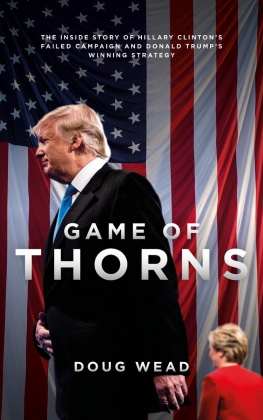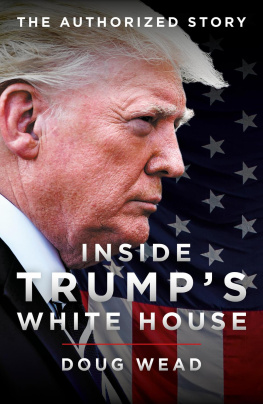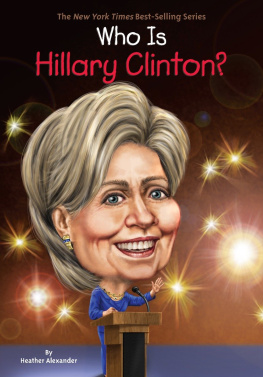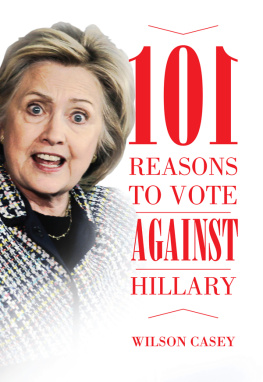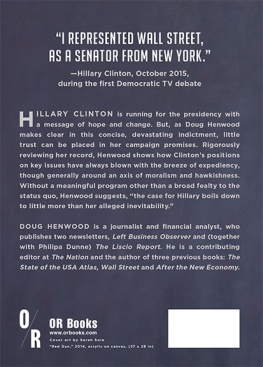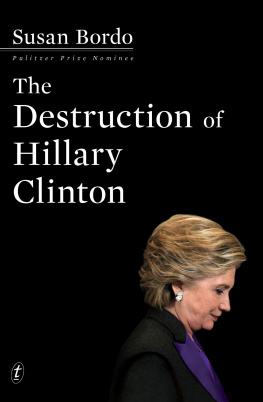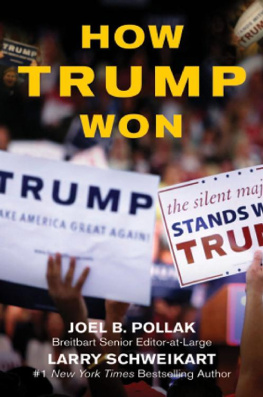Life can only be understood backwards; but it must be lived forwards.
S REN K IERKEGAARD
H ere was the plan: On January 20, 2017, Hillary Clinton would be inaugurated president of the United States. She would enter a pantheon of history that guaranteed greatness. She would be immortal. She would be compared to Cleopatra, Elizabeth I, Catherine the Great, and yet she would have more power than any of them ever had. She would instantly transcend other modern female leaders, such as Margaret Thatcher and Angela Merkel, because she would be running the worlds greatest superpower.
Catherine the Great ruled a backward nation of slaves. Elizabeth I lived in a world of equal rivals: Spain, France, and the Holy Roman Empire. During Cleopatras time, Egypt was a sideshow to the main event, which was the ongoing Roman Civil War. But Hillary Clinton would be president of the United States at a time when that powerful office was on steroids.
Then a strange thing happened. Suddenly there on the inauguration stage were new faces. It was as if the Clinton entourage had been photoshopped out of the picture. And yes, there he was, in the blustery wind, his hand on the Bible, his blond hair lifting at odd angles. It was the billionaire businessman Donald Trump, coarse, full of confidence. And just as he had fantasized, he was being sworn in as president of the United States.
It was as if time had folded in on itself. Had American history entered an alternate universe? Was this some new historical fiction produced on Amazon Prime? The neo-American version of The Man in the High Castle? In this eerily familiar new world, Hillary Clinton had not won the election after all. Donald Trump had.
What did it mean? How had the historic Clinton machine sputtered and failed at the last minute, just before the finish line? What had the pollsters and pundits and corporate television executives gotten wrong?
Nate Silvers brilliant blog FiveThirtyEight had placed the odds of a Hillary Clinton win at 71.4 percent to 28.6 percent. The New York Times gave her odds of 91 percent to 9 percent. New York magazine had already published its cover, a picture with the angry, contorted face of Donald Trump and the word Loser stamped across it in bold letters. A final kick in the pants from a corporate media arrayed against the brash businessman, whose golden Trump towers dared to rise amidst their skyline.
A week before the election, the Fox News anchor Megyn Kelly quizzed the pundits Karl Rove and Larry Sabato about an outlier poll showing Trump ahead in the race.
Rove was unimpressed. One odd poll was not enough. Hes got seven days and hes got to cover seven states, which is a very large number of states to be focused on as you come down to the end, Rove explained. He admitted that Trump was up in Iowa, Florida, and Ohio but down in North Carolina. He needed to win all of those states and two others that he was now losing.
What are the odds of that right now? Kelly asked.
Thats uphill, Rove said.
Larry Sabato, the director of the Center for Politics at the University of Virginia, was even more direct. Sabatos famous Crystal Ball, which had been featured on Fox News for months, had Clinton winning 322 electoral votes to 216 for Trump. He also projected that the Democrats would take control of the Senate.
The majority of the pundits on all of the major television networks, with the exception of Fox News, were arguably in the tank for Hillary Clinton, and Fox, as in the case of the Republican Party itself, was clearly divided.
Two hundred and forty newspapers had endorsed her candidacy. Nineteen had endorsed Donald Trump.
Hillary Clinton had spent a staggering $581 million. Her super PAC, Priorities USA, raised and spent more money, $192 million, than any super PAC in all of American history. Donald Trump, meanwhile, had raised and spent a total of $340 million, including $66 million of his own money. His Great American PAC, led by Eric Beach and Ed Rollins raised $32 million.
The former CEO of Google, Eric Schmidt, himself helped organize the Clinton campaigns technology system. The best and brightest of the nations data experts worked for her. Trump relied on his son-in-law Jared Kushner to come up with something.
Hillary Clintons staff outnumbered Trumps five to one. And their ground games could not be compared. On Election Day she would rely on an army of 960,000 volunteers. Nobody bothered to count what Trump would have in place. The manpower infrastructure that had once held up the mighty Republican National Committee for Ronald Reagan had all but evaporated.
Hillary Clintons own internal polls and computers, likewise, declared her the winner. That included the top-secret Ada, the magical Clinton software unique to her extraordinary run for the presidency. It was named after Ada Lovelace, a nineteenth-century
But then, Hillary Clinton did not win. She lost.
The morning after the 2016 presidential election, the Clinton machine seemed to be operating on autopilot, like a big 747 landing itself by computer. On a conference call, Hillary Clinton told major donors that the FBI director James Comeys letter to Congress was to blame for her defeat. There are a lot of reasons why an election like this is not successful, she said, Our analysis is that Comeys letter raising doubts that were groundless, baseless, proven to be, stopped our momentum.
She had not made the traditional appearance the night of her election loss. The losing candidate usually shows up to graciously concede, to unite the nation, and then to reassure the weeping children, the volunteers. Some of them had given up a year of college or put off marriage or rented apartments in New York City and Washington, DC, to work for her victory.
Early the morning after, a cacophony of iPhone beeps, rings, and chirps played across Manhattan as the Clinton team sent out one last text message to its top team. Hillary Clinton was giving her concession speech and they were needed. Exhausted, sleepless, brokenhearted, many of them wanted to pull the covers over their heads, but they had come a long way with Hillary, some of them years, too long to opt out of the final act.
They took taxis and buses and walked across Manhattan to gather at the Wyndham New Yorker. The ballroom was packed and the weeping inside was contagious. The trick was not to look at a friend, or as someone suggested, to think of Donald Trump in the Oval Office and the resultant anger would block the emotion.
Awaiting Hillary, the television cameras focused on the campaigns chairman, John Podesta. And then eventually Huma Abedin, Clintons longtime aide, walked into the room. There was a standing ovation for Huma. Then Hillary appeared close behind.
Her concession speech was short and widely praised in the media. Last night, I congratulated Donald Trump and offered to work with him on behalf of our country, she said. I hope that he will be a successful president for all Americans. This is not the outcome we wanted or we worked so hard for, and Im sorry that we did not win this election for the values we share and the vision we hold for our country.
iPhones buzzed as friends and relatives from across the country sent messages into the New Yorker ballroom. You are on CNN right now. We can see you on camera. You are on MSNBC. Fix your hair. Dont look so sad.
You represent the best of America, Hillary told this ballroom of her closest supporters, and being your candidate has been one of the greatest honors of my life. There were loud cheers. It was the last chance for many of them to applaud for her before scattering across the country to resume their lives.

